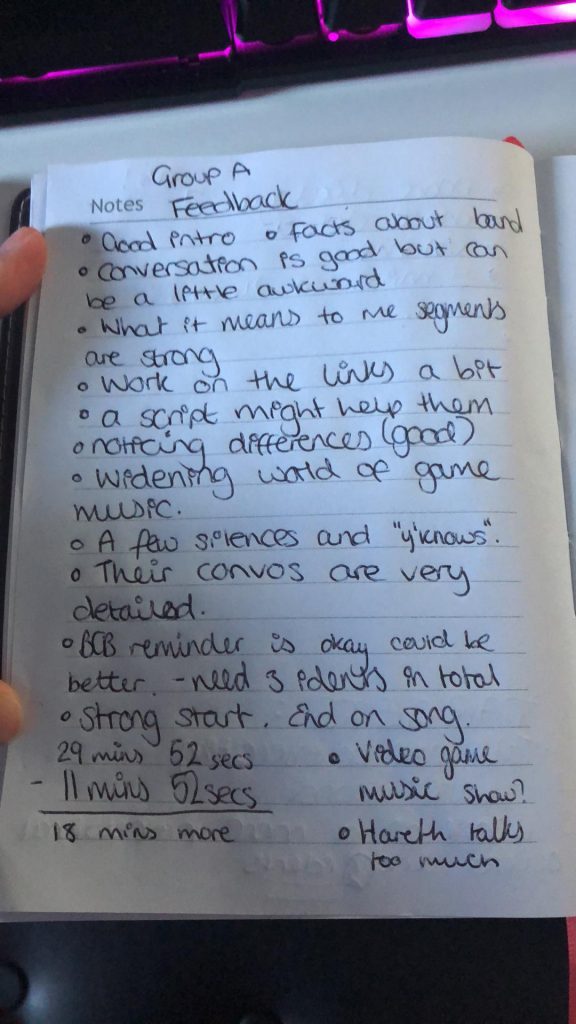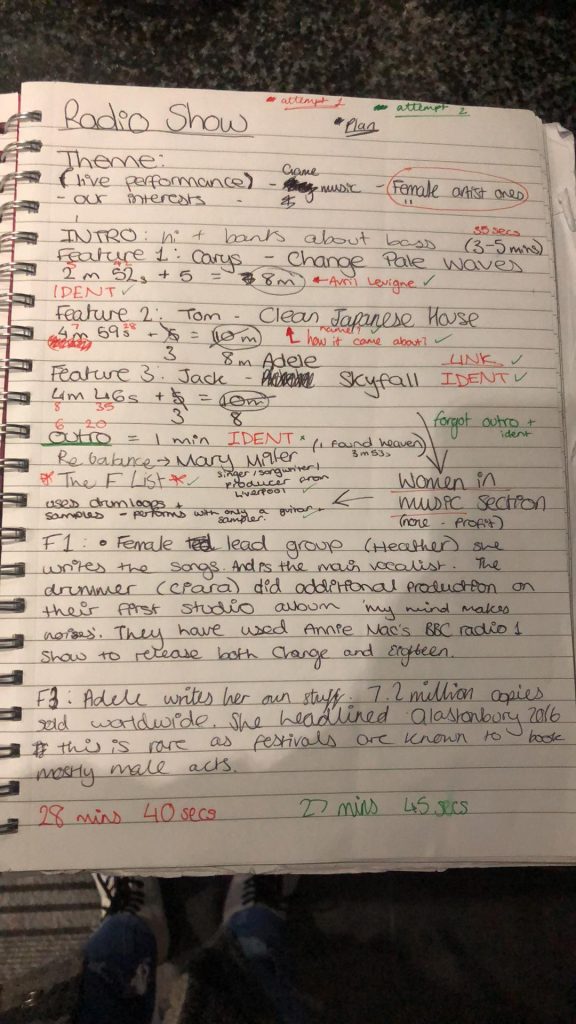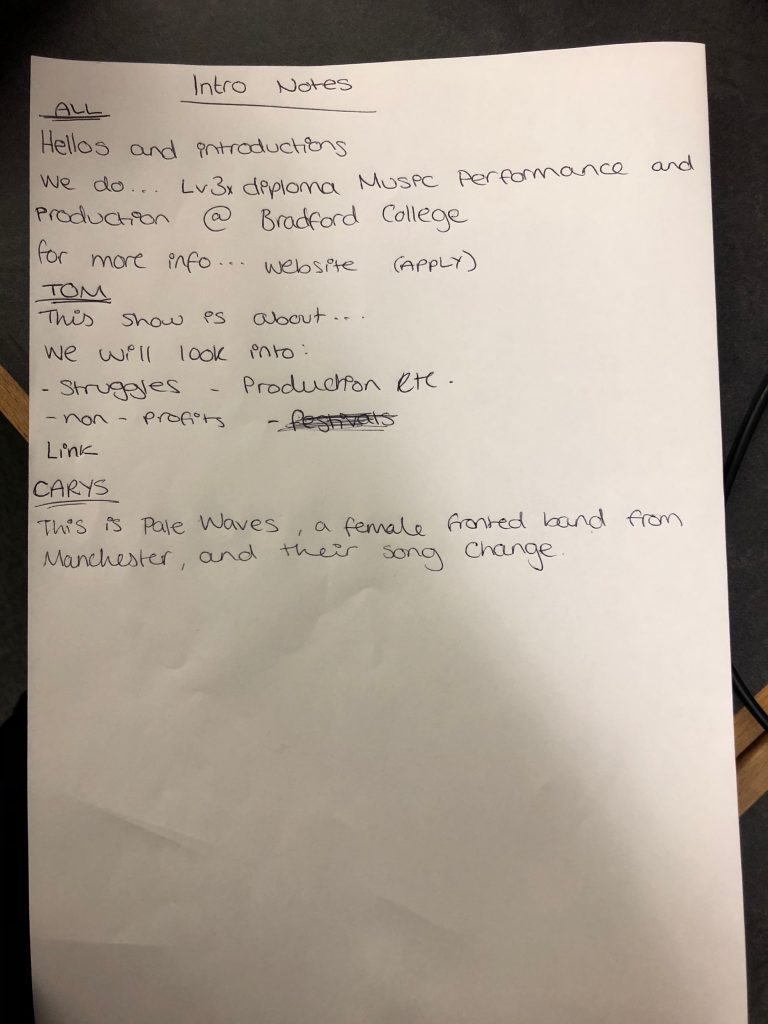Radio Practice:
Week 1:
Introduction
– This song is from Tyrone Wells’ EP Metal & Wood which was at the top of the iTunes billboard for 3 weeks holds a special meaning to many people.
Let Go – Tyrone Wells (4mins 19secs)
Why?
– I picked this song as many people can relate to different part of it.
What it means to me?
– This was played at my grandmas funeral but I don’t see it as a sad song because it is more like a story of life. It helped me to know that it was okay to let go of the sadness but keep the happy memories and I feel like that is something a lot of people forget at the moment so it is nice to be reminded.
The Practice:
This is our first practice attempt.
The second and improved attempt.
David Carpenter feedback:
- Really nice intro to the people in the room and what we’re gonna get.
- Good explanations about why people chose their songs.
- Jack – laid back delivery. No problem with that, but was hard to hear at times – just get closer to the mic.
- Rehearsed conversations (mostly) sound better the second time around!
- Work on the ending.
- Faster paced – you’re gonna get through 6 songs easily!
- When doing the full show, end on a song
Peer Feedback:
- Good info about the songs but could be more detail.
- Planned well.
- Confident – Informed listener of the station.
- More dialogue – general convo.
- Jack to speak louder or get closer to the mic (speak clearly).
- More detail about the songs
- Need 24mins 56 seconds to fill the time slot.
Targets:
- To talk in greater detail about the songs and other various points to make the show more interesting and to flow better.
- Be clear and concise when speaking, meaning work on positioning and projection.
- Work on being more professional and confident when carrying out a link, ident and the outro.
Week 2:
Giving feedback to my peers:
We listened to the show that Group A had done and discussed as a group. We came up with these notes:

We then started to create a plan for our actual radio show. After careful consideration, we decided to go with a show about female artists (see below).

As you can see, after brainstorming a few ideas for the theme we decided to go with a ‘Female Artists’ or ‘Women in Music’ show. Once we made this decision, the plan flowed very nicely. We decided to keep the same introduction as we used in the practice session because it had received positive feedback and set out a light-hearted tone.
Next, I began listing our ideas for each of our features. For my feature, I chose to play the song Change by Pale Waves. This is because the band is female-fronted. I also learned that their drummer Ciara helped with additional production on their first studio album ‘My Mind Makes Noises’ (My Mind Makes Noises — Pale Waves | Last.fm, 2020). Furthermore, The band is often influenced by other female artists such as Avril Lavigne (PALE WAVES – ‘CHANGE’ LIVE STREAM & Q&A, 2020).
Tom then chose to look at Clean by The Japanese House due to its production and Amber’s denial of gender norms and Jack chose to pick Adele because of the fact that she has headlined Glastonbury.
For the outro, we looked into non-profit organisations that support female musicians. First of all, we researched The F-List. The F-List aims to aid “female and gender minority musicians to overcome barriers by providing guidance, training and various professional opportunities.” It was set up by Anoushka Shankar, who is a female musician herself, and aims to allow women to “be able to more successfully start and sustain their careers in music for longer”.
We then looked further into a programme called ‘ReBalance Music’. It was set up by Melvin Benn, who is the managing director of Festival Republic and it aims to provide studio time for women in music. The idea came about after PRS carried out their annual ‘Women Make Music Evaluation’. They found out that “women represent 16% of UK songwriters and composers and that there is a lack of women in other roles across the industry” (Benn, 2020). We thought that the perfect way to end the show would be to look at artists who took part in this programme and play one of their songs. We chose Mary Miller, a singer/songwriter/producer from Liverpool (Benn, 2020) and her song I Found Heaven.
This is our first attempt:
Click to listen to attempt one.
After we did this, I took a red pen and wrote down things that we had missed and the time. We were a minute short of our target so I wrote down a few things to add, including idents and extra facts. I did this after the second attempt as well here is the edited plan and second attempt:

The second attempt at the official show.
In this show, I also discussed a Q&A that Pale Waves did on a Youtube live stream. Here is the link to that:
Week 3:
Receiving Feedback from David:
This feedback was helpful. Personally I thought that these points would help our show the most:
- You can speak to each other when the music is on! Use that time to plan what you’re talking about next.
- You realise you’re going to have to edit the songs afterwards right?
- Clunking around…
- Where are you recording – reverb.
- Timing Fades may save you….
- Record some stuff that might save you later – redo the intro, redo the outro…
Firstly, being able to speak during the songs because we will need to edit better quality tracks over the top. This meant that we were able to remind each other of what came next and to do a time check.
Secondly, “clunking around”. The point made here was more of a reminder that when we are moving around the mics can pick it up. Being at home for the session this week was helpful because we had the ability to mute our mics when we were not talking to limit distracting background noises.
Linking to the above point, the area we were using for recording had been a big echoey room with high ceilings and no carpets. This provided a lot of natural reverb but made the recording sound very strange. Thankfully, as I already mentioned, the recordings this week took place from the comfort of our own homes. This meant we all had separate microphones and space to help us sound clearer.
Next, was timing and using fades to give us more time if we run over. Before now, running over had not been a problem for us because we often ran out of things to talk about. This is due to not writing enough information during the planning stages.
Finally, redoing sections. We were of the mindset that if it was wrong we had to redo the entire show again. This is not true! We have to edit the show regardless of the problems we do or do not encounter. So it doesn’t harm us to just take a second to gather our thoughts and try again as it can be added later on.

In the above image are a few other points highlighted by David that we took into account when creating our targets:
- Do an outro, that contains an ident to summarise before 26 minutes 30 seconds.
- Discuss non-profit organisations in greater detail by using statistics.
- Make notes that may be helpful to the conversation.

Recording the show at home:
Just like last week, we started the session off by creating a plan. We used a lot of the same ideas as last week but focused on the timings of each section to try to get it perfect. We also wrote down more details about the small talking points such as festivals and non-profit organisations.

Then we got onto recording. Here are our attempts:
Attempt one of recording the show from home.
Week 3:
This week was all about editing our recordings and putting final touches on them. Before we started, we had a video call with David, who discussed some details with us such as improvements we could make and finding out how close we were to finishing. We got to a show that was approximately 29 minutes once all of the gaps and mistakes had been edited out. I decided to record a short audio section discussing more about the F-List as I missed out quite a bit of information during the recording.
The additional information I recorded.
This brought us to a time of 29 minutes 29 seconds, which meant there was still 23 seconds to fill. We decided to go with re-recording the intro. We did this in the studio at college, using an SE Titan vocal mic and Logic Pro X. We used a recording template with the original show, the new “audio” and the better-recorded intro.


Whilst Tom set that up, I wrote down some notes for us to use so that we knew exactly what to say to fill in the time. We asked Nic (our tutor) for his opinion and he reminded us that on a news channel, they quickly of all of the stories and topics that they will cover before the show so that the audience is aware and can hear more in detail throughout. We took that layout, introducing ourselves and summarising not just what the show is but what we will be discussing. We also decided to add in a link to the course we are on so that anyone who is interested is aware of where to look.

Final Radio Edit:
I am proud of our radio show for a few reasons. First of all, it is about a very interesting and heavy topic that many would be afraid to talk about. This made it a great show because it sparks interest as well as informing the listeners of a huge issue that effects the music industry and to say it is co-hosted by both males and a female is something I am proud to say makes the issue seem important to more people, as it should. Secondly, the show is heartfelt with a lot of the musical choices being songs that we relate to a lot. This added a personal touch.
I wish that I could have changed a couple of things. For example having Jack in the group. Mainly because he did not feel a connection to the topic and it was difficult to work with him as he is extremely quiet and withdrawn but also doesn’t listen to feedback. These personality traits made the recording process frustrating because he was always too quiet no matter how many times we asked him to talk louder or move closer. I also felt that I did a lot of his work for him like picking his song and researching some facts about it. I also would have changed the fact that we didn’t re record the whole thing to make the audio sound consistent as a few sections seemed off.
Overall, though, I am glad I had this opportunity. I feel like I have learned a lot and hope I can use the skills I gained to assist me in the final project. Whether it is in an interview or something else related to radio.
Bibliography:
Adkins, A., 2012. Skyfall. [online] Spotify. Available at: <https://open.spotify.com/track/6VObnIkLVruX4UVyxWhlqm> [Accessed 7 December 2020].
Bain, A., 2015. Clean. [online] Spotify. Available at: <https://open.spotify.com/track/2vIwwTufmg8YfZn5qvzxIg> [Accessed 7 December 2020].
Baron-Gracie, H., 2020. Change. [online] Spotify. Available at: <https://open.spotify.com/track/12RrfFKWOOzbhjt1LtQgxj> [Accessed 7 December 2020].
Benn, M., 2020. [online] ReBalance Music. Available at: <https://rebalancemusic.com/about-us/> [Accessed 1 December 2020].
Benn, M., 2020. [online] ReBalance Music. Available at: <https://rebalancemusic.com/about-us/> [Accessed 1 December 2020].
Last.fm. 2020. My Mind Makes Noises — Pale Waves | Last.Fm. [online] Available at: <https://www.last.fm/music/Pale+Waves/My+Mind+Makes+Noises> [Accessed 1 December 2020].
Miller, M., 2018. I Found Heaven. [online] Spotify. Available at: <https://open.spotify.com/track/07mYpsZh7ZRvzFe4BIUyEc?si=o6Vg7WCKQYqZPRoknQxEFg> [Accessed 1 December 2020].
Shankar, A., 2020. The F-List Directory Of UK Female Musicians. [online] The F-List Directory of UK Female Musicians. Available at: <https://thef-list.uk/> [Accessed 1 December 2020].
Wells, T., 2010. Let Go. [online] Spotify. Available at: <https://open.spotify.com/track/4x4kWOHUdKCbnjEW5c2qMJ> [Accessed 24 November 2020].
Youtu.be. 2020. PALE WAVES – ‘CHANGE’ LIVE STREAM & Q&A. [online] Available at: <https://youtu.be/et3ttVrTgAU> [Accessed 10 November 2020].
